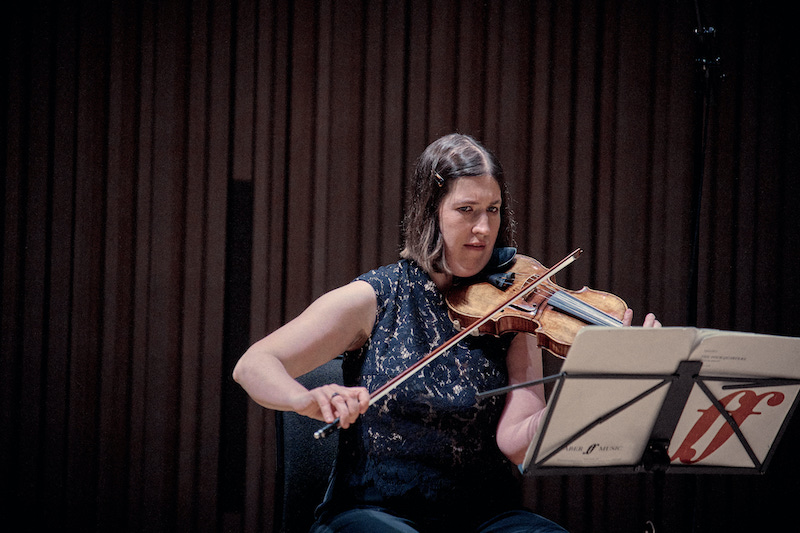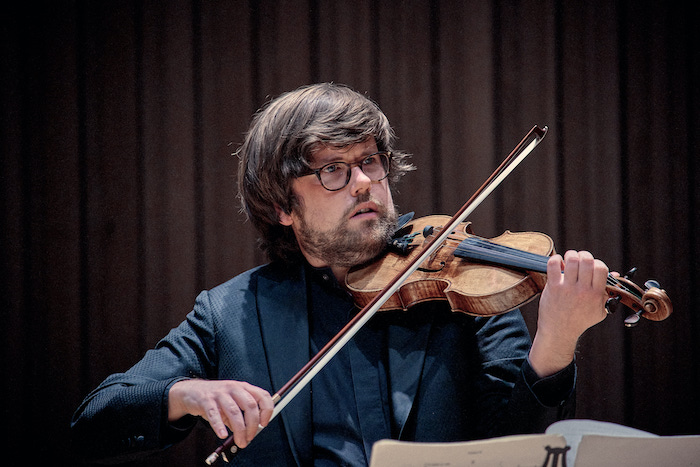Castalian Quartet, Stoller Hall, Manchester online review - mercurial playing fits a varied programme | reviews, news & interviews
Castalian Quartet, Stoller Hall, Manchester online review - mercurial playing fits a varied programme
Castalian Quartet, Stoller Hall, Manchester online review - mercurial playing fits a varied programme
Haydn and Adès rub shoulders in a recital of drama and excitement

The Polyphonic Concert Club is a collective of musicians – including Isata Kanneh-Mason and I Fagiolini – offering recorded chamber recitals released weekly through March and April.
There were three pieces on the programme: Haydn’s C major quartet, op.20 no.2, Thomas Adès’ The Four Quarters and Janáček’s 'Kreutzer Sonata' Quartet (No 1), which required the Castalians to traverse a wide range of territory, aesthetically, technically and emotionally. The quartet has been playing together since 2011 and their sound is muscular and assertive but not without lightness of touch, and they found a terrific dynamic range. Like the best quartets they move and breathe together and clearly engaged with all three pieces in their different ways.
 Haydn’s opus 20 set established many of the principles of string quartet that held sway for the next century, but always with his sardonic humour and subversiveness. The Castalians avoided romanticising Haydn’s classical language in the slow movement and were impish in the fugal finale. First violin Sini Simonen (pictured above) carried this forward with an effortless phrasing of the fugue’s themes and there was a real sense of contrapuntal conversation between the parts.
Haydn’s opus 20 set established many of the principles of string quartet that held sway for the next century, but always with his sardonic humour and subversiveness. The Castalians avoided romanticising Haydn’s classical language in the slow movement and were impish in the fugal finale. First violin Sini Simonen (pictured above) carried this forward with an effortless phrasing of the fugue’s themes and there was a real sense of contrapuntal conversation between the parts.
Thomas Adès – who has recently celebrated his 50th birthday – was represented by his 2010 The Four Quarters, whose movements journey through the course of a day. It has his usual mastery of texture, elusive rhythms and allusive harmony. The Castalians were more than equal to the many technical demands of the piece but went beyond that to draw out the expressiveness of the piece. The first movement is my favourite, hocketing patterns between the upper strings never quite landing where you expect, the structural build-and-fall-away paced beautifully by the quartet. After the second movement’s frenetic barrage of pizzicato and the sonorous repetition of the third, the fourth – called ‘The Twenty-Fifth Hour’ – is an otherworldly dream of pizzicato and harmonics which eventually floats away into a ghostly D-major chord.
Janáček’s 'Kreutzer Sonata' Quartet has no such moments of dream or repose, but is rather anguished music of confrontation. This is not reassuring music; it is not pretty or comforting, but it demands a response, even if that response is one of discomfort. The Castalians engaged with the music on both a technical and emotional level, finding its stormy, restless heart.
 We have travelled a long way from the soundworld of Haydn. Where the Adès’s piece is thoroughly, avowedly post-tonal Janáček’s clings by its fingertips to a kind of modality but it is bursting at the seams, and this sense of desperation was present in the playing. The severe, scratchy ponticello playing in the third movement was emphatic, second violinist Daniel Robert’s (pictured above) crazed arpeggios in the fourth movement were adamantine, and there was a delicious coldness in the still opening to the final movement. You want drama? There’s drama here. Looking for consolation and good cheer? Look elsewhere.
We have travelled a long way from the soundworld of Haydn. Where the Adès’s piece is thoroughly, avowedly post-tonal Janáček’s clings by its fingertips to a kind of modality but it is bursting at the seams, and this sense of desperation was present in the playing. The severe, scratchy ponticello playing in the third movement was emphatic, second violinist Daniel Robert’s (pictured above) crazed arpeggios in the fourth movement were adamantine, and there was a delicious coldness in the still opening to the final movement. You want drama? There’s drama here. Looking for consolation and good cheer? Look elsewhere.
The whole thing was really beautifully filmed – possibly the best picture editing of any of the filmed concerts I’ve watched. In particular I enjoyed the pacing of the cuts being in tune with the pacing of the music: there was a real synchrony there. The only real disappointment was the lack of programme notes – there wasn’t even a breakdown of the movements – and I think subscribers could have expected more in this respect. But in all others they should be well satisfied.
rating
Explore topics
Share this article
The future of Arts Journalism
You can stop theartsdesk.com closing!
We urgently need financing to survive. Our fundraising drive has thus far raised £49,000 but we need to reach £100,000 or we will be forced to close. Please contribute here: https://gofund.me/c3f6033d
And if you can forward this information to anyone who might assist, we’d be grateful.

Subscribe to theartsdesk.com
Thank you for continuing to read our work on theartsdesk.com. For unlimited access to every article in its entirety, including our archive of more than 15,000 pieces, we're asking for £5 per month or £40 per year. We feel it's a very good deal, and hope you do too.
To take a subscription now simply click here.
And if you're looking for that extra gift for a friend or family member, why not treat them to a theartsdesk.com gift subscription?
more Classical music
 From Historical to Hip-Hop, Classically Black Music Festival, Kings Place review - a cluster of impressive stars for the future
From quasi-Mozartian elegance to the gritty humour of a kitchen inspection
From Historical to Hip-Hop, Classically Black Music Festival, Kings Place review - a cluster of impressive stars for the future
From quasi-Mozartian elegance to the gritty humour of a kitchen inspection
 Shibe, LSO, Adès, Barbican review - gaudy and glorious new music alongside serene Sibelius
Adès’s passion makes persuasive case for the music he loves, both new and old
Shibe, LSO, Adès, Barbican review - gaudy and glorious new music alongside serene Sibelius
Adès’s passion makes persuasive case for the music he loves, both new and old
 Anja Mittermüller, Richard Fu, Wigmore Hall review - a glorious hall debut
The Austrian mezzo shines - at the age of 22
Anja Mittermüller, Richard Fu, Wigmore Hall review - a glorious hall debut
The Austrian mezzo shines - at the age of 22
 First Person: clarinettist Oliver Pashley on the new horizons of The Hermes Experiment's latest album
Compositions by members of this unusual quartet feature for the first time
First Person: clarinettist Oliver Pashley on the new horizons of The Hermes Experiment's latest album
Compositions by members of this unusual quartet feature for the first time
 Gesualdo Passione, Les Arts Florissants, Amala Dior Company, Barbican review - inspired collaboration excavates the music's humanity
At times it was like watching an anarchic religious procession
Gesualdo Passione, Les Arts Florissants, Amala Dior Company, Barbican review - inspired collaboration excavates the music's humanity
At times it was like watching an anarchic religious procession
 Classical CDs: Camels, concrete and cabaret
An influential American composer's 90th birthday box, plus British piano concertos and a father-and-son duo
Classical CDs: Camels, concrete and cabaret
An influential American composer's 90th birthday box, plus British piano concertos and a father-and-son duo
 Cockerham, Manchester Camerata, Sheen, Martin Harris Centre, Manchester review - re-enacting the dawn of modernism
Two UK premieres added to three miniatures from a seminal event of January 1914
Cockerham, Manchester Camerata, Sheen, Martin Harris Centre, Manchester review - re-enacting the dawn of modernism
Two UK premieres added to three miniatures from a seminal event of January 1914
 Kempf, Brno Philharmonic, Davies, Bridgewater Hall, Manchester review - European tradition meets American jazz
Bouncing Czechs enjoy their Gershwin and Brubeck alongside Janáček and Dvořák
Kempf, Brno Philharmonic, Davies, Bridgewater Hall, Manchester review - European tradition meets American jazz
Bouncing Czechs enjoy their Gershwin and Brubeck alongside Janáček and Dvořák
 Solomon, OAE, Butt, QEH review - daft Biblical whitewashing with great choruses
Even a top soprano and mezzo can’t make this Handel paean wholly convincing
Solomon, OAE, Butt, QEH review - daft Biblical whitewashing with great choruses
Even a top soprano and mezzo can’t make this Handel paean wholly convincing
 Two-Piano Gala, Kings Place review - shining constellations
London Piano Festival curators and illustrious friends entertain and enlighten
Two-Piano Gala, Kings Place review - shining constellations
London Piano Festival curators and illustrious friends entertain and enlighten
 Echo Vocal Ensemble, Latto, Union Chapel review - eclectic choral programme garlanded with dance
Beautiful singing at the heart of an imaginative and stylistically varied concert
Echo Vocal Ensemble, Latto, Union Chapel review - eclectic choral programme garlanded with dance
Beautiful singing at the heart of an imaginative and stylistically varied concert
 Scott, Irish Baroque Orchestra, Whelan, RIAM, Dublin review - towards a Mozart masterpiece
Characteristic joy and enlightenment from this team, but a valveless horn brings problems
Scott, Irish Baroque Orchestra, Whelan, RIAM, Dublin review - towards a Mozart masterpiece
Characteristic joy and enlightenment from this team, but a valveless horn brings problems

Add comment